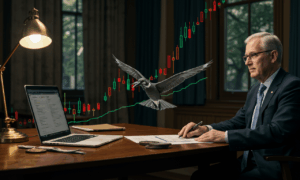ECONOMY
This week, all eyes were on the U.S. Federal Reserve as it concluded its latest policy meeting. The central bank decided to hold its benchmark interest rate steady, which was widely expected. However, the big news was in its projections for the future. Officials now anticipate only one interest rate cut in 2024, a significant reduction from the three cuts they had projected back in March. This indicates that the Fed remains cautious about inflation and wants to see more consistent proof that price pressures are cooling before it begins to lower borrowing costs. For consumers, this means that rates for mortgages, car loans, and credit cards are likely to remain elevated for longer than previously hoped.
In a positive sign for the inflation fight, the Producer Price Index (PPI) for May showed a surprise decrease. The PPI measures the average change over time in the selling prices received by domestic producers for their output. Think of it as inflation at the wholesale level, before goods reach the consumer. A drop in the PPI suggests that cost pressures for businesses are easing, which could lead to lower consumer prices down the line. This data, which came out just after the Fed’s meeting, provided a dose of optimism that inflation is indeed heading in the right direction, even if the path is a bit bumpy.

FINANCE
Diving deeper into the Federal Reserve’s decision, a key focus was the so-called dot plot. This is a chart that graphically represents each Fed official’s anonymous projection for the future path of the federal funds rate. This week’s dot plot revealed a more ‘hawkish’ stance, which is financial slang for favoring tighter monetary policy to combat inflation. While the median forecast was for one rate cut this year, several officials saw no cuts at all. This tool provides valuable insight into the range of opinions within the Fed’s committee and underscores the consensus that the bank is in no rush to ease its policy, prioritizing the battle against persistent inflation over providing immediate relief to borrowers.
Across the Atlantic, financial markets in Europe experienced a bout of turbulence, particularly in France. The uncertainty stemmed from a snap legislative election called by French President Emmanuel Macron. The possibility of a significant political shift has made investors nervous, leading to a sharp sell-off in French stocks, especially major banks. The spread, or difference, between French and German government bond yields widened, a classic sign of perceived risk. This serves as a potent reminder that geopolitical events can have a swift and significant impact on financial stability and investor confidence, affecting everything from stock markets to government borrowing costs.
INVESTMENTS
The technology sector continues to be a major engine for the stock market. This week, semiconductor giant Broadcom saw its stock soar after reporting stronger-than-expected earnings. The company, which makes a wide array of chips and software, is benefiting enormously from the boom in Artificial Intelligence (AI). On top of its impressive results, Broadcom also announced a 10-for-1 stock split, which will make its shares more accessible to a wider range of investors. A stock split doesn’t change a company’s fundamental value, but it often generates positive sentiment and can boost demand for the shares.
Another software titan, Adobe, also delivered a stellar earnings report that sent its stock price higher. The company behind Photoshop and Acrobat saw strong demand for its suite of digital media and marketing products. A key driver of this success has been the successful integration of AI features into its software, which is attracting and retaining customers. This reinforces a dominant theme in today’s investment landscape: companies that effectively harness and monetize artificial intelligence are being rewarded handsomely by investors, often driving broader market indices like the S&P 500 to new heights.
Frequently Asked Questions (FAQ)
Why is the Federal Reserve only planning one rate cut when inflation seems to be improving?
The Federal Reserve is taking a very cautious approach. While some recent reports like the PPI have been positive, other measures of inflation have remained stubbornly above the Fed’s 2% target. They want to see a sustained trend of cooling prices over several months before they feel confident enough to cut rates. Cutting too soon could risk reigniting inflation, which would be harder to control later. They are trying to strike a delicate balance between controlling inflation and not slowing down the economy too much.



